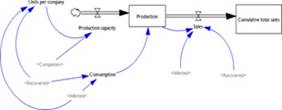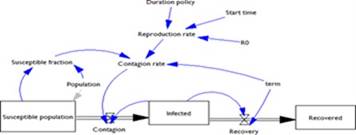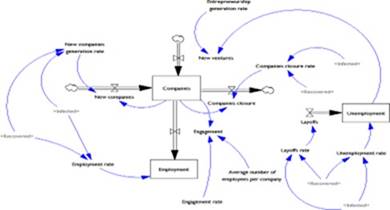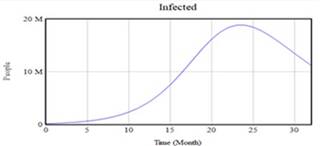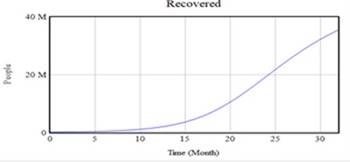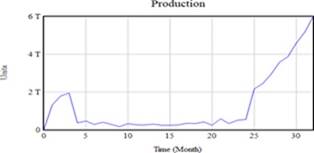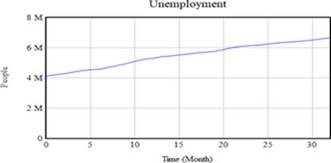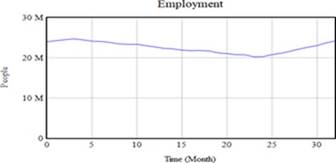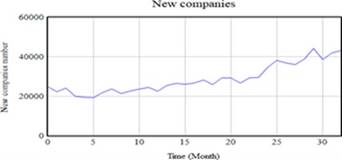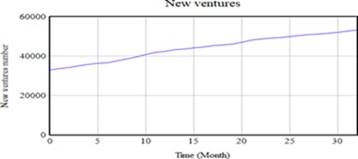Introduction
Employment is defined as the territory ability to offer all its population employability and paid work. In this regard, employment is a relevant element in the economic and country development terms. Employment variable is interrelated with important social welfare indicators such as diet, education, and health, boosting industrial development. According to 1, maintaining the growing trend in macroeconomic indicators is strategically important for attracting investors to a country.
Covid 19 pandemic was a disruptive event which triggered a worldwide economic crisis, causing a drastic increase in inequality within and between countries 2. In Latin America, the pandemic caused the worst economic recession in the last 100 years, generating a contraction in the region’s gross domestic product in 2020, which led to an increase in the number of people living in poverty 3, thus leading many households to seek new employment alternatives in a way which will guarantee a minimum income to ensure their food security.
Recently in the Colombian context, the health emergency decreed by COVID-19 has generated an economic and social disruption as well individuals as organizations in the country, affecting macroeconomic variables greatly. In this sense 4 remarked about economic uncertainty caused by the health emergency and, economy decline translated as unemployment higher levels, inequality and poverty. which makes it necessary to adopt a resilient position around decisions to confront the health emergency. Resilience is understood as an individual or institutional capacity to resist adversity, developing different strategies to emerge stronger from said situation. Moreover 3-4) points as relevant to know prospectively the employment behaviour under a pandemic situation in Colombian. In this research, employment resilience will be analysed in terms of entrepreneurship and new companies generated in the context of covid 19 pandemic.
This research document aims to present a dynamic analysis regarding employment resilience variable under a health emergency scenario in a developing country. Consequently, a current problem brief description is addressed in the first instance, followed by a secondary sources literary review to consolidate a conceptual framework. Later, different relevant variables are identified in order to build causal and Forrester diagrams to simulation execution. Finally, System behaviour conclusions are made as well as variable of interest recommendations.
Background and literature review
Employment is a dynamic variable that is subject to the constant economic fluctuation of a country 7. It is then context and country-based and needs then to be addressed in relation to spatial and socio-economic variables that can be specific of each context. Furthermore, each element interrelated with it interacts in such a way that the entire system is affected, making the global analysis of all those factors implicit in economic activity relevant. According with 8 greater public investments allow a greater country economic growth, which includes the generation of employment. In addition, 9 present a comparative economic behavior analysis between Eurozone and United States of America. In both, great impact in unemployment was a result of strict confinements. Mention the need to offer tax aid to companies and citizens, due to the great jobs lost generated by the pandemic. Additionally, 10 analyze the consumers purchasing behavior along 2020 and conclude that consumption goods and services changed drastically due to unemployment. In the same way, Colombia is suffering the consequences caused by pandemic, therefore, the different organizations and institutions included in the country’s economic system are in uncertain.
Latin America experienced one of the largest economic contractions in its history due to the pandemic, increasing unemployment and poverty conditions in the region 11. Similarly, pandemic had major negative repercussions on employment and economic stability of small and medium-sized enterprises, since, despite aid programs to ensure their survival, a large number of companies were forced to close 12. Likewise, 13 conducted a study to measure resilience of rural Latin American populations to the covid 19 pandemic, where detected that due to economic poverty of these regions, rural inhabitants were forced to undertake new business opportunities to increase their cash flow.
Pandemic caused an economic recession in Colombia, forcing the definition of public policies to address these problems, which, added to internal social and governmental instability, has halted the country’s recovery 6. In accordance with the above, the national government has taken different measures to control the spread of the pandemic; quarantines, partial closures of different economic sectors and social isolation are among the decisions made by the country’s leaders regarding the current situation. According to 14 these strategies have become a turning point for economic development and all its aggregates, since for a developing country the total or partial closure of sectors generates a total setback in all indicators relevant to the proper functioning of an economy. Similarly, 15 maintains that, since the start of the pandemic in March, until the end of May, around 5 million jobs have been lost in Colombia, in turn pointing out the criticality of this value regarding the economic future from the country.
In this sense, understanding employment as a variable sensitive to possible changes in the different economic indicators, it is relevant to understand the total performance of the system to analyze the behavior of the variable of interest under the scenario of a health emergency. Due to all the above, the following research question is formulated: Is employment a resilient variable in the face of economic changes produced by the health emergency?
Employment has certain characteristics as they are; inclusive and sustainable development, which is relevant to the economic evolution of society and the improvement of the population’s quality of life through increased income. For 16 employment can be assumed as the direct amount of work that varies depending on the number of companies in each territory and period. For this reason, 17 exposes the importance of explicitly maintaining the relationship between employment and development, since paid work makes it possible to increase household income, contributing significantly to the expansion and diversification of the economy. It is important to highlight that monetary policy focuses on the combination of price stability with the maximum sustainable growth of output and employment 18. Consequently, 19 indicates that changes in reforms and some decisions taken on the development of cities are closely related to the dynamism of employment, having a considerable impact on trends in the short, medium, and long term. Meanwhile, 20 points out that development without employment is an obstacle to the growth of production since this shows fallacies regarding the distribution of income, indicating once again that growth and employment feed off each other. Also 21, study the employment offer and demand during pandemic in Moldova, that although there is a migration to remote work, many jobs are lost, which requires government support measures to avoid, major impacts on the economic development of that country. On the other hand, 22 indicates employment as a resilient indicator in the face of crisis situations, since the population looks for different ways to generate income when they are in a recession position, being the creation of companies or entrepreneurship one of the strategies most common to generate profit and in turn employment. For this reason and understanding the importance of employment in the economic system, different authors in the literature have focused their efforts on using different methodologies and approaches that allow guaranteeing a calculation closely related to the real situation of the variable of interest. Such is the case of 23, who exposes the dynamics of systems as an eminent and constructive tool that simplifies the analysis of the model in different situations, based on the available knowledge regarding how its parts are articulated, thus providing an adjusted result to reality based on the time spent. For this reason, authors such as 24 use a system dynamics model to measure different variables such as reemployment, layoff and job quit rates in different political scenarios, to evaluate those strategies that contribute to employment generation within a country.
Methodology
The methodology should be organized as follows in Figure 1, which consists of three main phases: in first phase, an analysis of the context (Colombia employment during COVID-19) is made, Subsequently, in the second phase, a causal diagram is constructed to capture the different interrelationships that have the most relevant variables of the system under study, here, the different influences that some aspects have on others are analyzed, in such a way that the modeling and construction of the system simulation. Finally, in third phase, based on different authors consulted in the literature, a Forrester diagram is developed through the VENSIM PLE x64 simulation program to know the results of the proposed system and made some conclusions about this situation.
Results
Characterization
According to 25, covid 19 pandemic affected the employment and income of many Colombians, especially those most vulnerable population groups, which depended to a greater extent on informal jobs that were affected by decisions such as quarantines. From this inconvenience, innovation and entrepreneurship strategies emerged as a way to respond to the social and economic problems resulting from the pandemic 26, which has directly reflected a recovery in the income level of the population 25. These researches validate direct relationship which exists between employment and the country’s economic development and encourage a detailed analysis of how different government decisions in terms of employment can affect the country’s recovery in a post-pandemic era.
Causal loop diagram
It is relevant to know the system behavior in the short and medium term, since the decisions taken under this situation entail different effects on the country economy. According to (8-10) among others, different implicit variables in the economic activity considered in the study must be, employment, number of companies, sales, production and unemployment. In addition, the Susceptible-Infected-Recovered (SIR) Model to analyze the behavior of COVID-19 in Colombia is included. The variables behavior such as, income generation, life quality improvement and social development in Colombia were taken from sources such as 18. The above allows, configuring a causal diagram to represents the system behavior and variables interrelationships. Figure 2.
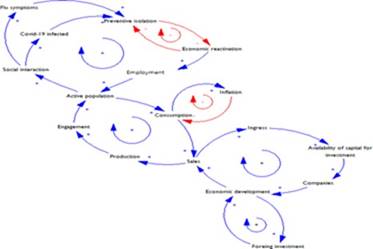
Source: authors
Figure 2 Causal diagram on the different relevant economic variables and the influence of Covid-19
According to the feedback loops shown in Figure 2 and considering the different causal interrelationships for interpretation, the following behaviors can be described: An increase in social interaction causes greater flu symptoms in the population, in the same way, this interaction generates a greater number of infected by COVID-19. This consecutively produces greater social isolation, negatively affecting a possible economic reactivation. If the system experiences a greater economic reactivation, an increase in employment is expected, since, with greater commerce, it is estimated that the number of employed persons will increase. Having a higher level of employment causes an increase in the active population, considering that this indicator refers to the sum of people employed with those who are looking for said opportunity. However, it is necessary to consider consumption and a possible inflation derived from its increase, since, by experiencing higher rates of employment and active population, a significant increase in sales can be estimated, in turn, said increase has a significant impact on positive in the number of units produced by each company, making it necessary to increase the contracting margin to improve the capacity to respond to said sales. Similarly, an increase in the number of sales causes a higher income to be received, making the availability of capital for investment greater and, therefore, the number of companies in the territory increases, making the country’s development increase considerably. In turn, the foregoing causes a greater attraction of foreign investors, considering this investment as part of the economic and business development of the country. Having stated the above, variables causal relationships were defined to represent the system’s global behavior.
Forrester diagram
The initial simulation model has 32 months as a horizon time. It focuses from system thinking as an analysis mode that allows evaluating all the interrelated parts in this economic model. Then analysis is supported in the system dynamics in order to establish future performance based on the different interrelated variables behavior.
Taking as reference criteria presented in 27 four sets of variables were defined. Level variables account for the situation state in terms of employment capacity (in number of companies), actual employment/unemployment, production (and thus contribution to the country’s GDP) and population affected by COVID-19 or susceptible to be. Flow variables such as new ventures, new companies, layoffs, companies close, engagements and sales, represent the enter an exits in each level variable. Then auxiliary variables and parameters were defined. (Appendix No. 1).
Production is analyzed in a Forrester diagram (Figure 3) on two representative level variables: Production and total accumulated sales. In addition, the COVID-19 behavior in Colombia is shown (Figure 4) on base in SIR model (Susceptible, infected, recovered), taken as a reference (Borbón, 2014). Likewise, three level variables as Companies, Employment and Unemployment in (Figure 5), are analyzed, based on the Colombia pandemic behavior. Finally, it should be noted that the data used to carry out the equations of the Forrester diagram were taken from government information such as 28.
After having raised the previous model, the simulation is carried out using the VENSIM PLE x64 tool, for a time horizon of 32 months. In addition, the results of the most relevant variables of the system and how they affect the variable of interest are exposed. The results can be seen in the following figures:
In Figure 6 an exponential increase in the number of people infected by COVID-19 can be observed, which reaches its maximum point between months 20 and 25. After this, a notable decrease in infections and a possible projection can be identified of a downward trend of these. This variable is of interest to the research because if there is an increase in the number of infected persons, government finds necessary to establish measures to restrict the population, which directly influences their ability to acquire stable employment.
According to Figure 7, it can be inferred that the number of recovered responds to the number of infected people, since as seen, this curve tends to continue increasing as time passes. As the number of people recovered increases, the restrictions imposed are reduced, making it possible for the population to have access to a decent job that guarantees an income for their household.
Regarding the production behavior shown in Figure 8, a certain dynamism can be observed in the period studied, since this variable is closely linked to the proposed SIR model. For this reason, a slight decline in the number of units produced in month 5 is estimated, followed by a stable behavior with an upward trend due to the increase in the number of recovered for this date. Finally, the graph indicates a considerable increase in production from month 25. The increase in the country’s production contributes to an improvement in the economy, which in turn impacts indicators such as the rate of formal employment by companies.
In Figure 9, an increase in the number of unemployed people in the national territory can be found, closely approaching the forecasts described by the different authors mentioned in this research. For this graph, there is an initial value of 4 million 114 thousand unemployed people, which as time begins to increase until reaching a point where the number is 6 million 481 thousand. It should be noted that these results are linked to the effects of the pandemic on the Colombian economy.
According to Figure 10, a noticeable decline in the number of people employed can be analyzed until month 24, after this, a slight increase in the indicator can be observed from month 25. This graph shows the behavior of the employment under the effects of the pandemic, since in relation to Figures 1 and 2, a convergence is found in the critical months for these variables.
Regarding the variables of interest shown in Figures 11 and 12, a resilient behavior is clearly observed on the generation of entrepreneurships and new companies in the national territory, said behavior can be explained as a response to the growth of unemployment denoted in Figure 9, likewise, implicit in this dynamic is the behavior of those infected by COVID-19 and people recovered from this virus, since causally it is necessary that the greater the number of infected, the economic reactivation will be less.
Following this order of ideas, these graphs demonstrate the inherent capacity of the Colombian population to resist different adversities from extraordinary situations, such as the COVID-19 pandemic. On the other hand, it can be inferred that the generation of employment through entrepreneurships and new companies will be increasing, since the results presented above indicate that by month 32 the number of entrepreneurships and new companies will be around 51,404 and 46929, respectively.
The results of variables like employment and new companies generated are validated by the behavior of the post-pandemic Colombian economy in 2022, which reflects the recovery of the pre-pandemic employability rate and an increase in different economic indicators of the country.
Conclusions
The analysis of the behavior of a macroeconomic variable, such as employment, generates a breadth of relevant information regarding the dynamism of the economic system, since, as they are interrelated variables, the effects of different external or extraordinary factors such as is the COVID-19 pandemic can cause a total disruption in matters of planning and future control of the country’s economic indicators.
On the other hand, it can be concluded that employment is a resilient variable in the face of different adversities, since as indicated by the results presented above, a considerable increase in the number of entrepreneurships and companies created in response to the unemployment situation can be evidenced. In the same way and with emphasis on the authors consulted above, the population looks for a way to generate income from their own knowledge or skills, being the generation of entrepreneurships or companies one of the most used strategies in terms of growth and job development. It is also important to specify that the impact of government policies to stimulate employment has not been included in the context of this analysis, an aspect that should be included in subsequent studies.
Finally, it is recommended that countries with emerging economies consider the behavior of the different variables set out in this article, to promote and adopt strategies that allow generating a constant development of the different economic indicators of the country when it is in a health emergency scenario.















